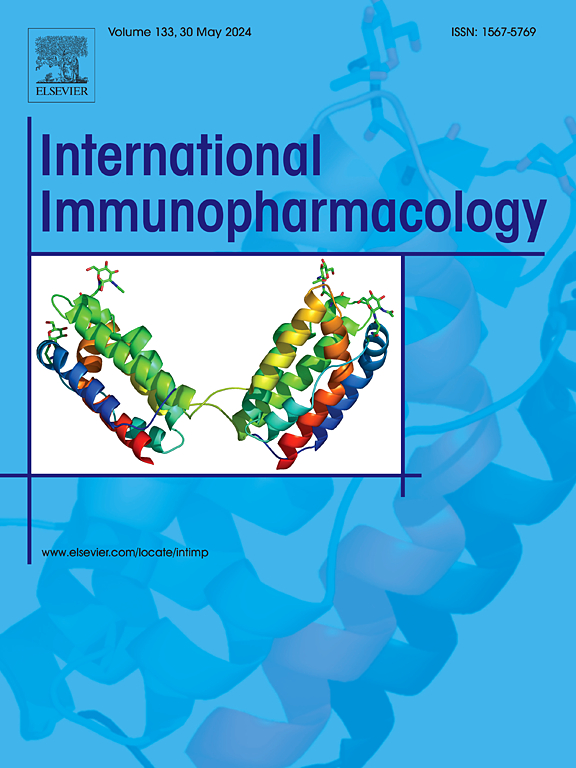Polymethoxylated flavones for modulating signaling pathways in inflammation
IF 4.8
2区 医学
Q2 IMMUNOLOGY
引用次数: 0
Abstract
Aberrant signaling pathways play a crucial role in the pathogenesis of various diseases, including inflammatory disorders and autoimmune conditions. Polymethoxylated flavones (PMFs), a class of natural compounds found in citrus fruits, have obtained increasing attention for their potential therapeutic effects in modulating inflammatory responses. Although significant progress has been made in the pharmacological research of PMFs, the mechanisms by which they modulate signaling pathways to treat inflammation have not been systematically reviewed or analyzed. To address this gap in the literature, this review explores the mechanisms underlying the anti-inflammatory properties of PMFs and their prospects as drugs for treating inflammatory diseases. We discuss the molecular targets and signaling pathways through which PMFs exert their anti-inflammatory effects, including NF-κB pathway, PI3K/Akt pathway, MAPK pathway, Nrf2 pathway, and regulation of inflammatory cytokine production. Furthermore, we highlight preclinical studies evaluating the efficacy of PMFs in various inflammatory conditions, such as rheumatoid arthritis (RA), inflammatory bowel disease (IBD), and osteoarthritis (OA). Despite promising findings, challenges remain in optimizing the pharmacokinetic properties and therapeutic efficacy of PMFs for clinical use. Future research directions include elucidating the structure–activity relationships of PMFs, developing novel delivery strategies, and conducting large-scale clinical trials to validate their efficacy and safety profiles. Overall, PMFs represent a promising class of natural compounds with potential applications as anti-inflammatory drugs, offering novel therapeutic opportunities for managing inflammatory diseases.
用于调节炎症信号通路的聚甲氧基黄酮。
信号通路异常在各种疾病(包括炎症性疾病和自身免疫性疾病)的发病机制中起着至关重要的作用。多甲氧基化黄酮(PMFs)是柑橘类水果中的一类天然化合物,因其在调节炎症反应方面的潜在治疗作用而受到越来越多的关注。虽然 PMFs 的药理研究取得了重大进展,但它们调节信号通路以治疗炎症的机制尚未得到系统的回顾或分析。针对这一文献空白,本综述探讨了 PMFs 抗炎特性的内在机制及其作为治疗炎症性疾病药物的前景。我们讨论了 PMFs 发挥抗炎作用的分子靶点和信号通路,包括 NF-κB 通路、PI3K/Akt 通路、MAPK 通路、Nrf2 通路和炎症细胞因子产生的调节。此外,我们还重点介绍了评估 PMFs 在各种炎症中疗效的临床前研究,如类风湿性关节炎(RA)、炎症性肠病(IBD)和骨关节炎(OA)。尽管研究结果令人鼓舞,但在优化 PMF 的药代动力学特性和治疗效果以用于临床方面仍存在挑战。未来的研究方向包括阐明 PMFs 的结构-活性关系、开发新型给药策略以及开展大规模临床试验以验证其疗效和安全性。总之,PMFs 是一类前景广阔的天然化合物,具有作为抗炎药物应用的潜力,为治疗炎症性疾病提供了新的治疗机会。
本文章由计算机程序翻译,如有差异,请以英文原文为准。
求助全文
约1分钟内获得全文
求助全文
来源期刊
CiteScore
8.40
自引率
3.60%
发文量
935
审稿时长
53 days
期刊介绍:
International Immunopharmacology is the primary vehicle for the publication of original research papers pertinent to the overlapping areas of immunology, pharmacology, cytokine biology, immunotherapy, immunopathology and immunotoxicology. Review articles that encompass these subjects are also welcome.
The subject material appropriate for submission includes:
• Clinical studies employing immunotherapy of any type including the use of: bacterial and chemical agents; thymic hormones, interferon, lymphokines, etc., in transplantation and diseases such as cancer, immunodeficiency, chronic infection and allergic, inflammatory or autoimmune disorders.
• Studies on the mechanisms of action of these agents for specific parameters of immune competence as well as the overall clinical state.
• Pre-clinical animal studies and in vitro studies on mechanisms of action with immunopotentiators, immunomodulators, immunoadjuvants and other pharmacological agents active on cells participating in immune or allergic responses.
• Pharmacological compounds, microbial products and toxicological agents that affect the lymphoid system, and their mechanisms of action.
• Agents that activate genes or modify transcription and translation within the immune response.
• Substances activated, generated, or released through immunologic or related pathways that are pharmacologically active.
• Production, function and regulation of cytokines and their receptors.
• Classical pharmacological studies on the effects of chemokines and bioactive factors released during immunological reactions.

 求助内容:
求助内容: 应助结果提醒方式:
应助结果提醒方式:


